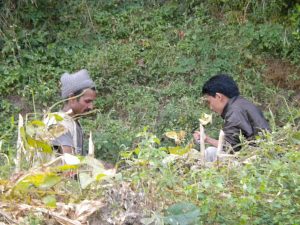The single biggest reason that the appropriate technology movement died and most technologies for developing countries never reach scale is that nobody seems to know how to design for the market.
Over the past 30 years, I’ve looked at hundreds of technologies for developing countries.
Some provided elegant solutions for challenging technical problems. Some were big and clumsy. Some were far too expensive. Some of were beautifully simple and radically affordable.
But only a handful were capable of reaching a million or more customers who live on less than two dollars a day.
If you succeed, against all odds, in designing a transformative radically affordable technology, you still have addressed only 25 % of the problem. The other 75% is marketing it effectively, which requires designing and implementing an effective branding, mass marketing and last mile distribution strategy.

Any competent electrical engineer can design a beautiful solar lantern that provides enough light to read or cook by in a village thatched roof house. But designing it with the features that a poor family is willing to pay for, at a price providing them a 4 month payback from savings in kerosene, batteries and candles, is an entirely different matter.
Designing a branding and marketing strategy and a last mile supply chain that will put it in the hands of a million or more customers is three quarters of the design challenge.
Eight Practical Steps to Design for the Market
1. Interview 25 Likely Customers before you start.
We planned to sell battery charging services to villagers in eastern India using affordable solar technology, but when we interviewed 30 customers in ten remote villages, we learned that there wasn’t enough market demand to justify it. Many villages were being electrified, and what we learned is that when one village gets electricity, the fifty villages around it within a half hour bicycle ride get functional electricity, because villagers prefer to put a battery on a bicycle and plug it in at a village with electricity, to paying more money to a village solar powered battery charging service.
2. Design to a Customer–Derived Target Price–point from the very beginning
The reason US $10 is a sweet spot price point for solar lanterns for customers in developing countries who earn less than $2 a day is that most of them spend $3-$5 a month on kerosene, flashlight batteries and candles. If they save $2 a month after subtracting costs like battery replacement for the lantern, they get their money back in five months, which falls into the 2-300% return on investment most poor customers look for.
3. Select the price/effectiveness Tradeoffs Acceptable to Customers to reach the target price

Government standards for a subsidized solar lantern in India called for 8 days of reserve light for days when the sun didn’t shine. But when I interviewed 25 people who had used solar lanterns in Kenya for a year and asked them what their source of light was before the solar lantern, they said they used kerosene lamps, which they still had. So one trade-off to reach the target price of $10 is to bring the number of days of reserve light to zero. Any rational poor customer will gladly use their kerosene lamp on dark days if they can bring the price of the solar lantern down to what is affordable for them
4. Create a Proof of Concept Prototype

When we designed the first proof of concept prototype for a low cost drip system in Nepal, we simply drilled holes as emitters in black High Density Polyethylene Pipe lateral lines, and let water flow through them from a 55 gallon drum about 2 meters above the ground. Then we put a glass under each emitter and measured how much water came out over a fixed period of time. The proof of concept prototype worked well.
5. If it Works, Put it in the Hands of at Least Ten Customers, learn what’s wrong with it, and fix it.
When we put these prototypes in the hands of ten one acre farmers in the hills of Nepal for one growing season, they told us that water squirted sideways out of the holes away from the plants, so we put plastic sleeves over the holes. Then the plastic sleeves came away from the holes when the lateral lines were shifted, so we designed and extruded a baffle that fit snugly over the holes and didn’t move when the lateral lines were shifted.
6. Design a Branding, Marketing and Distribution Strategy capable of reaching a million customers
With the treadle pump in Bangladesh, we used staff from a commercial marketing firm in Dhaka to create the name Krishak Bandhu, meaning farmers’ friend, which is also now being used in India. We implemented a strategy of recruiting 75 small manufacturers, 3,000 village dealers, and about 3,000 well drillers, each of whom acted in their own economic self-interest to make market and install treadle pumps. Then we launched a national marketing initiative, including Bollywood type movies, to create sufficient volume sales to make each of the small enterprises in the last mile supply chain profitable

7. Field Test the Technology and the Branding, Marketing and Last Mile Distribution Strategy in at least five different villages for at least four months, and modify it from what you learn.
Windhorse International, the new private company I founded, is currently testing our strategy to sell safe drinking water to people without it in ten villages for six months, with a full independent evaluation. We have changed our strategy in at least six important ways already. For example, we introduced attractive jerry cans, but when they fell off the rack of customers bicycles, they dented easily, so we had to double their wall thickness.
8. Scale Up Systematically to Reach at Least a Million Customers
IDE reached 1.5 million customers in Bangladesh simply by replicating the model of manufacturers, dealers, and well drillers supported by IDE staff to reach scale in more and more geographic regions, and putting a lot of emphasis on supporting the Krishak Bandhu brand and national mass marketing campaigns.
Design for the Market: Practical Examples
The following video is a little long, but if you can suffer through it for nine minutes, it describes how three real social enterprises need to change what they are doing to reach a mass market.

Pingback: Designing products for BOP customers « Compassion in Politics: Christian Social Entrepreneurship, Education Innovation, & Base of the Pyramid/BOP Solutions
Business Process Re-Engineers have extensive experience helping companies design new products for the market. I have tried to use the principals of BPR to help NGOs understand what it takes to design a new product for the market as shown at my website at http://home.comcast.net/~prigter/site/. See the “Poverty” paper and the “Bangladesh” paper in particular. BPR is a field that was developed by industry and is not well understood by the academic community. MIT, Michigan, and a few other schools are just beginning to recognize the importance of BPR. The company that I worked for had a 10 volume set of information telling me what to do. The BPR principles also are used to make Government organizations more efficient. I used BPR concepts to help NASA, the FAA, the Coast Guard, DoD Health Systems, and FEMA. I also used the BPR principles to help Government leaders improve agriculture in Egypt, Morocco, Colombia, Russia, India, and other countries.
Thanks for the insights regarding a “proof of concept” prototype. I’ve been currently working on figuring out some drip irrigation considerations using pressure in-line calculations, but the calculations consider a much different scale.
Thanks for this valuable information. I have a brief story about #2: Pricing for the Marketplace. I was recently in West Africa consulting with a start-up social enterprise providing affordable land titles for the poor. The potential investor wanted the price point to be around $35 per certificate, but for the company to be ultimately profitable we needed to start at $65 per unit. To my absolute surprise, when I interviewed prospective customers from low to middle income households, they all said that they would be willing to pay $150-$200 for the ability to prove that the land was in their name. So essentially we were underpricing our services and could go higher in our initial pricing and as a result we could be profitable in 3-5 years instead of 8-10….all the while providing a unique, valuable and affordable service for our BOP customers.
The morale of this for me was that we need to break our false assumptions that BOP customers will always aim low or undervalue a service or technology to get it cheap. The trick is in taking the time to ask the right questions and actually listen to the answers.
Pingback: Santiago's Blog
My spouse and i have been checking into solar power for nearly a year or so and as a result the two of us last but not least made the decision based mainly on the blend of the governtment incentive programs and additionally exceptionally practical credit. My spouse and i have actually already been looking into solar for about a couple of years and as a consequence we last but not least made the decision based upon upon the mix of governtment incentive opportunities along with extremely practical lending. I essentially couldn’t imagine how inexpensive it all ended up being not to mention my partner and i already have been another solar energy home for around a month’s time in addition almost everything seem like it is in fact working out great. We can also honestly watch exactly how much electric power our organization aer reducing every single day of the week and it is really incredible. I alway thought that solar energy is promoted because of a good deal of hype however , My partner and i can easily reveal you the fact that it is without a doubt the bona fide deal. My partner and i wish my spouse and i had done this a long time ago.
This is a wise web site. I indicate it. You have so substantially expertise about this concern, and so considerably passion. You also know how to make people rally behind it, of course from the responses. Youve obtained a layout right here thats not also flashy, but can make a statement as huge as what youre stating. Terrific position, indeed.
Pingback: Weekly Review – September 12th – September 25th | Invested Development
Pingback: Development Engineering: A Critical Overview - The Berkeley Science Review